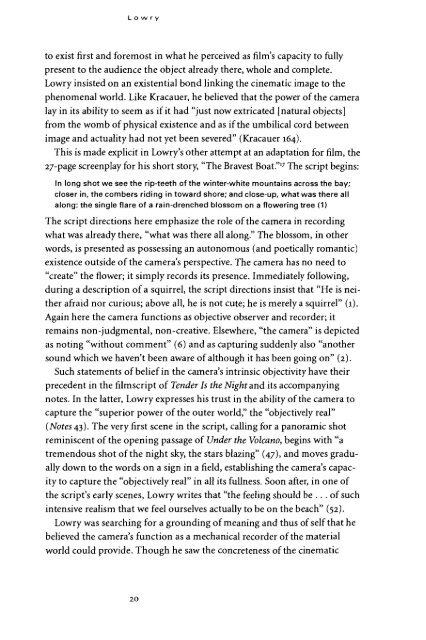A Quarterly of Criticism and Review i^^^^^^^^fcEjfc $15
A Quarterly of Criticism and Review i^^^^^^^^fcEjfc $15
A Quarterly of Criticism and Review i^^^^^^^^fcEjfc $15
You also want an ePaper? Increase the reach of your titles
YUMPU automatically turns print PDFs into web optimized ePapers that Google loves.
Lowryto exist first <strong>and</strong> foremost in what he perceived as film's capacity to fullypresent to the audience the object already there, whole <strong>and</strong> complete.Lowry insisted on an existential bond linking the cinematic image to thephenomenal world. Like Kracauer, he believed that the power <strong>of</strong> the cameralay in its ability to seem as if it had "just now extricated [natural objects]from the womb <strong>of</strong> physical existence <strong>and</strong> as if the umbilical cord betweenimage <strong>and</strong> actuality had not yet been severed" (Kracauer 164).This is made explicit in Lowry's other attempt at an adaptation for film, the27-page screenplay for his short story, "The Bravest Boat." 17 The script begins:In long shot we see the rip-teeth <strong>of</strong> the winter-white mountains across the bay;closer in, the combers riding in toward shore; <strong>and</strong> close-up, what was there allalong: the single flare <strong>of</strong> a rain-drenched blossom on a flowering tree (1)The script directions here emphasize the role <strong>of</strong> the camera in recordingwhat was already there, "what was there all along." The blossom, in otherwords, is presented as possessing an autonomous (<strong>and</strong> poetically romantic)existence outside <strong>of</strong> the camera's perspective. The camera has no need to"create" the flower; it simply records its presence. Immediately following,during a description <strong>of</strong> a squirrel, the script directions insist that "He is neitherafraid nor curious; above all, he is not cute; he is merely a squirrel" (1).Again here the camera functions as objective observer <strong>and</strong> recorder; itremains non-judgmental, non-creative. Elsewhere, "the camera" is depictedas noting "without comment" (6) <strong>and</strong> as capturing suddenly also "anothersound which we haven't been aware <strong>of</strong> although it has been going on" (2).Such statements <strong>of</strong> belief in the camera's intrinsic objectivity have theirprecedent in the filmscript <strong>of</strong> Tender Is the Night <strong>and</strong> its accompanyingnotes. In the latter, Lowry expresses his trust in the ability <strong>of</strong> the camera tocapture the "superior power <strong>of</strong> the outer world," the "objectively real"(Notes 43). The very first scene in the script, calling for a panoramic shotreminiscent <strong>of</strong> the opening passage <strong>of</strong> Under the Volcano, begins with "atremendous shot <strong>of</strong> the night sky, the stars blazing" (47), <strong>and</strong> moves graduallydown to the words on a sign in a field, establishing the camera's capacityto capture the "objectively real" in all its fullness. Soon after, in one <strong>of</strong>the script's early scenes, Lowry writes that "the feeling should be ... <strong>of</strong> suchintensive realism that we feel ourselves actually to be on the beach" (52).Lowry was searching for a grounding <strong>of</strong> meaning <strong>and</strong> thus <strong>of</strong> self that hebelieved the camera's function as a mechanical recorder <strong>of</strong> the materialworld could provide. Though he saw the concreteness <strong>of</strong> the cinematic20
















